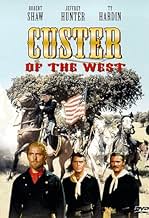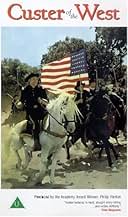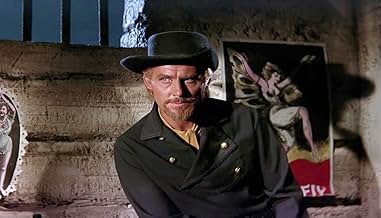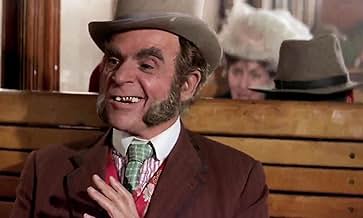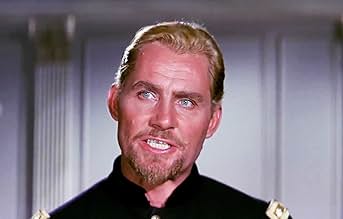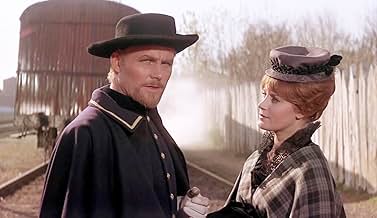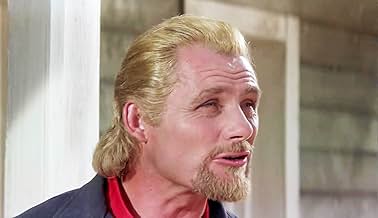PUNTUACIÓN EN IMDb
5,8/10
1,7 mil
TU PUNTUACIÓN
El amor de George Armstrong Custer por las tradiciones heroicas y su disgusto por la llegada de la industrialización le conducen a su destino en Little Big Horn.El amor de George Armstrong Custer por las tradiciones heroicas y su disgusto por la llegada de la industrialización le conducen a su destino en Little Big Horn.El amor de George Armstrong Custer por las tradiciones heroicas y su disgusto por la llegada de la industrialización le conducen a su destino en Little Big Horn.
Charles Stalmaker
- Lt. Howells
- (as Charles Stalnaker)
Argumento
¿Sabías que...?
- CuriosidadesOriginally to be directed by Akira Kurosawa, but he pulled out.
- PifiasThe troops of the 7th Cavalry are shown with 1873 Winchester rifles, which were in wide use by 1876, but not by the US Army. Custer's men were armed, as all troopers who did not purchase their own rifles were, with the 1873 Springfield Trapdoor carbine, a single-shot weapon. Had Custer's men been armed with the Winchester, it is possible, though unlikely, that they could have held out until relieved.
- Citas
Gen. Philip Sheridan: You know, you could become a living legend... or get yourself killed. Dead men make better legends.
- Versiones alternativas35mm prints released in both complete and shortened versions. Some shortened versions were titled "A Good Day for Fighting".
- ConexionesFeatured in I am not your negro (2016)
Reseña destacada
I won't go on too long about this. It's an efficiently told, largely fictional story of Custer and his last stand, sweetened up for the Whites in the audience and for their children.
It's impossible to imagine an American Indian watching this without feeling nauseous. Kieron Moore as Dull Knife. And at the end Custer seems to be fighting the Cheyenne -- period -- whereas he fought Sioux almost entirely. There were only seven Cheyenne warriors present at the battle. Westerns seem to enjoy dealing with the Cheyenne whenever they need generic Indians. I think it may be the name of the tribe -- The Cheyenne. It's easy to pronounce, and it sounds good. (It means something like "people with red feet" in Cheyenne.) "Sioux," on the other hand, sounds like a girl's name. "Apache" and "Comanche" are euphonious generic names too, but it's hard to get them all the way up to Montana. So what are you left with -- "Paiute"?
I didn't mind Robert Shaw's accent. He's a decent playwright but, regardless of which accent he's using, he can project nothing more than grim determination. When he seems to be enjoying himself, maybe smiling, you can't help feeling that it's calculated, that he's grimly determined to smile. As written, his role doesn't tell us much about Custer. Sometimes he seems brutal and other times, without too much tiresome exposition, he sounds like a liberal. Mary Ure is really appealing, a decent actress, without being staggeringly beautiful, who died an untimely death. Ty Hardin wasn't much of an actor, and he seemed to go politically bonkers after his brief career as a handsome hunky type. Jeffrey Hunter has a small part as the voice of humanitarianism. Lawrence Tierney has a beaut of a New York accent, but it may not be too out of place. Phil Sheridan was from New Jersey, wasn't he? (I may be wrong, but I don't want to bother looking it up.) Robert Ryan is the best actor in the bunch and his part is completely unnecessary, adding nothing to the picture.
The last stand is epic in a way it probably wasn't in real life, if that matters at all. The dead cavalrymen all wind up in something like a circular pile instead of being scattered along the slope up which they retreated. The Indians leave the remains alone, too, instead of violating them as they actually did. (Custer's body was stripped but unmutilated.) Indians tend not to like this kind of movie. On the anniversary of the battle in 1988 they installed a small plaque of crude, angry cast iron commemorating the many Indians who died in the battle. Right in the shadow of the phallic needle that remembers the 7th Cavalry. As it happens, I was living with the Cheyenne as an anthropologist at the time. I have never met a more admirable people. You don't hear much about Indian resentment of White's assumed superiority because they don't shout loud enough. Jane Fonda on her return from France in 1970 found them boring and too fond of alcohol so she went on to more exciting things.
It's impossible to imagine an American Indian watching this without feeling nauseous. Kieron Moore as Dull Knife. And at the end Custer seems to be fighting the Cheyenne -- period -- whereas he fought Sioux almost entirely. There were only seven Cheyenne warriors present at the battle. Westerns seem to enjoy dealing with the Cheyenne whenever they need generic Indians. I think it may be the name of the tribe -- The Cheyenne. It's easy to pronounce, and it sounds good. (It means something like "people with red feet" in Cheyenne.) "Sioux," on the other hand, sounds like a girl's name. "Apache" and "Comanche" are euphonious generic names too, but it's hard to get them all the way up to Montana. So what are you left with -- "Paiute"?
I didn't mind Robert Shaw's accent. He's a decent playwright but, regardless of which accent he's using, he can project nothing more than grim determination. When he seems to be enjoying himself, maybe smiling, you can't help feeling that it's calculated, that he's grimly determined to smile. As written, his role doesn't tell us much about Custer. Sometimes he seems brutal and other times, without too much tiresome exposition, he sounds like a liberal. Mary Ure is really appealing, a decent actress, without being staggeringly beautiful, who died an untimely death. Ty Hardin wasn't much of an actor, and he seemed to go politically bonkers after his brief career as a handsome hunky type. Jeffrey Hunter has a small part as the voice of humanitarianism. Lawrence Tierney has a beaut of a New York accent, but it may not be too out of place. Phil Sheridan was from New Jersey, wasn't he? (I may be wrong, but I don't want to bother looking it up.) Robert Ryan is the best actor in the bunch and his part is completely unnecessary, adding nothing to the picture.
The last stand is epic in a way it probably wasn't in real life, if that matters at all. The dead cavalrymen all wind up in something like a circular pile instead of being scattered along the slope up which they retreated. The Indians leave the remains alone, too, instead of violating them as they actually did. (Custer's body was stripped but unmutilated.) Indians tend not to like this kind of movie. On the anniversary of the battle in 1988 they installed a small plaque of crude, angry cast iron commemorating the many Indians who died in the battle. Right in the shadow of the phallic needle that remembers the 7th Cavalry. As it happens, I was living with the Cheyenne as an anthropologist at the time. I have never met a more admirable people. You don't hear much about Indian resentment of White's assumed superiority because they don't shout loud enough. Jane Fonda on her return from France in 1970 found them boring and too fond of alcohol so she went on to more exciting things.
- rmax304823
- 20 mar 2004
- Enlace permanente
Selecciones populares
Inicia sesión para calificar y añadir a tu lista para recibir recomendaciones personalizadas
- How long is Custer of the West?Con tecnología de Alexa
Detalles
- Fecha de lanzamiento
- Países de origen
- Idioma
- Títulos en diferentes países
- La última aventura
- Localizaciones del rodaje
- Empresas productoras
- Ver más compañías en los créditos en IMDbPro
Taquilla
- Presupuesto
- 4.000.000 US$ (estimación)
- Duración2 horas 20 minutos
Contribuir a esta página
Sugerir un cambio o añadir el contenido que falta

Principal laguna de datos
By what name was La última aventura del general Custer (1967) officially released in India in English?
Responde
